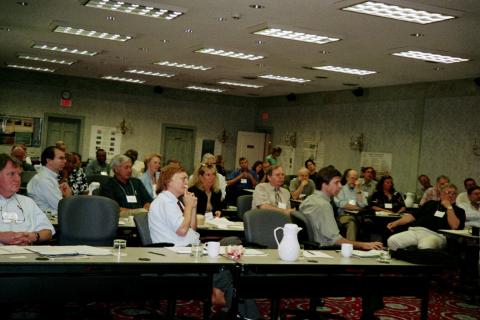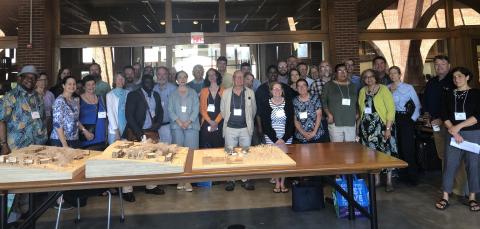The National Council for Science and the Environment (NCSE) has played a seminal role in the evolution of the environmental and sustainability fields within the academic community and how the results of scholarship and training impact the decisions we make in society. From its founding in 1990 through its renaming as the National Council for Science and the Environment in 2000 to its present, it has carried out a crucial mission—to improve the scientific basis of environmental decision-making (see the essay by Ahmed and Hubbell for more details of those early years). One key element of the 2000 rebranding was a gathering together of academic leaders of environmental programs that became the Council of Environmental Deans and Directors, more recently renamed the NCSE Alliance of Sustainability and Environmental Academic Leaders (NCSE Leaders’ Alliance).
The academic community has always had an interest in the big challenges in society, partly through the vision of some of its leaders and a lot of it through the passions of its students! The first environmental programs emerged in the 1960s, mostly at small liberal arts colleges or within some larger universities in response to a specific local event like an oil spill. They were each unique to their institutional settings. Many of the early programs were most heavily grounded in the social sciences. In the 1980s and 1990s, there emerged a large number of new programs, many of which were outgrowths of natural science and geography departments. These early programs were usually more interdisciplinary than their academic neighbors and, due to the subject, more connected to policy and social needs. However, many were still quite academic in character and still limited in their effectiveness at achieving interdisciplinary success in institutions dominated by strong departments and schools. The leaders of these programs were constantly searching for ways to continue to grow.
In 2000, NCSE asked the deans of four prominent environmental programs to send out a letter to about 40 of their peers. About 20 of us showed up at the first NCSE conference and, on the following Saturday, we sat in a hotel conference room to ask a simple question: What could we do collectively to improve academic environmental programs? We had as many ideas as there were programs and the surety that each of our ideas were something that others should adopt. A smaller group was tasked with taking the discussion and making a plan. We met for a few days the following June at the Missouri Botanical Garden. We used the template of similar organizations in ocean science, policy schools, and professional societies to look at both what we would want to accomplish and how we could execute on it. The following January, at the second NCSE conference, a larger group again met in a hotel conference room on a Saturday to agree among ourselves that we would join together to create the Council of Environmental Deans and Directors (CEDD) under the NCSE umbrella. I was honored to be elected the first president.

One of the oddities of running an environmental program in those days is that the leaders all came from different disciplines and academic communities. We rarely knew each other in our earlier academic years within a discipline. The colleges in the Northeast had a group of leaders that met regularly, but that was a rarity in the larger field. CEDD created a place where we could meet and learn from each other and a peer group on which we could rely. I called it creative, consensual “thievery.” The whole point was to expose each other to the things that worked in our organizations so that others could borrow the elements that would work for them.
This sharing ranged from program design, effectiveness, curriculum, student recruitment, diversity, working with businesses, raising money, and the perennial challenge of managing the relationships with university presidents. We also studied ourselves and our programs to move beyond the old dichotomies of environmental “studies” versus “science” or “breadth” versus “depth” to an understanding that we were solving challenges in a complex, multi-dimensional space where your program needs were governed by the paths to solution in the intersection of that challenge and your own specific strengths. We developed ways to partner more effectively with each other and with communities outside of academia.
The net result was that we became better and did so more rapidly than on our own. When we had challenges or needed an external review, we now had peers that we could call on who understood our unique challenges. As successful program models were more understood, they would propagate. Programs became institutes, departments, or schools and these units began to take on cross-university structures. We improved the articulation between high school, community colleges, and four-year colleges and universities for these subjects. Some institutions, notably Arizona State University, inculcated sustainability across the entire university as a core value in every department, setting a new standard for what could be accomplished with support at the presidential level. CEDD could then help promulgate these examples to other deans and directors and presidents. Equally critical, CEDD created and spread a set of best practices for how to reduce the disciplinary barriers to tenure for interdisciplinary, under-represented, and nontraditional faculty. These pragmatic levels of support are critical for ensuring quality, status, and longevity within academia going forward.
One special characteristic of an environmental program is that it is defined as much by its value outside the university as within academia alone. It is more like engineering or medicine in this regard at the interface of basic and applied. Interdisciplinary scholarship itself can be done in many homes with an improved toolkit for how to manage these kinds of projects. The key difference for an environmental program is that the needs of society are critical to the scholarship and it is the responsibility of the program, faculty, and students to make that value real. This means that programs engage with communities of decision-makers at the local, state, and federal level to get their knowledge into play. Environmental programs have long had links to the advocacy sector. Through CEDD meetings, members learned how to do outreach to industry groups, companies, and entrepreneurs. No longer just the “enemy” of the environment, many of these companies, properly provisioned with people and knowledge, can be agents of positive change. Today a chief sustainability officer is central to most larger companies and many of these people came from the very environmental and sustainability programs that did the best jobs of managing the academia-business interface.
I think that the success of the modern environmental and sustainability programs owes a lot to what CEDD, now the NCSE Leaders’ Alliance, was able to create and is still creating for the future. Challenges and opportunities do remain. Climate change is happening faster than society is ready. Science itself is under assault. Environmental and sustainability programs still don’t reach business interests as effectively as needed. I feel that student leaders need to be able to get better training in leadership and fiscal management as they take the reins of organizations. I think that environmental challenges need to be understood as complex adaptive systems and we still lack adequate tools to realize the implications and opportunities from this characteristic.

NCSE, the NCSE Leaders' Alliance, and the many related organizations—each creating their own value—have prepared the ground for our future. The students we train are the leaders of the future and they are more ready than any previous generation. As we plan for the next 30 years of NCSE, I foresee that the kind of integrated value that the NCSE Leaders’ Alliance brings to academia is as critical to the future as it has been to the path to the present. We are stronger as we work together, building on each other’s strengths and gaining from the knowledge and wisdom that we can each provide. Our challenge will be scale. However, as Arizona State University President Michael Crow says about academia, “we have 100% of the students.” If all colleges and universities can lead by example and train for a sustainable future, the actions of these generations of students—rising to leadership—will change the world.